Page 2

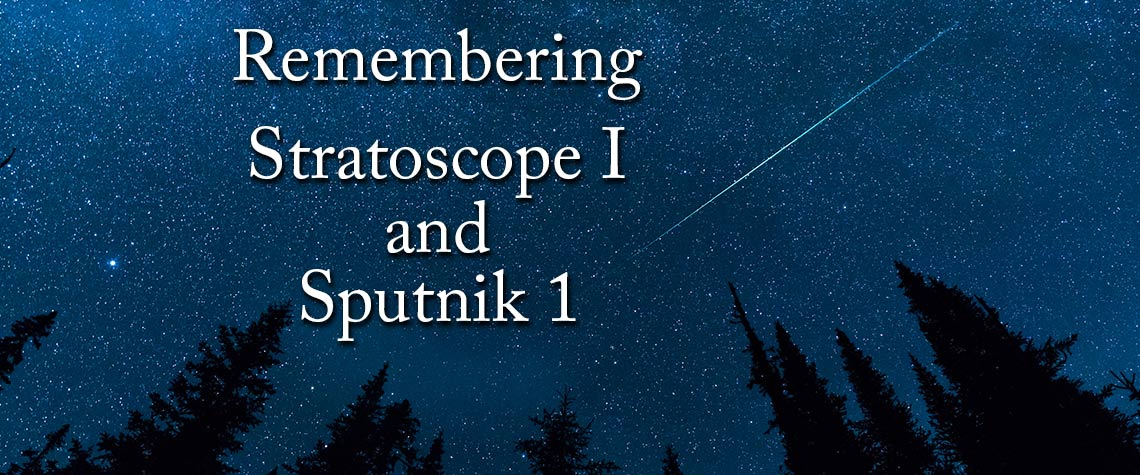
My Pre-NASA Memoirs, Part II
By Karl J. Aufderheide, Ph.D.
Although the High Dive project balloon flight did not generate all the results it was supposed to, balloon flights continued throughout 1957 and many years subsequently. Later in the summer of 1957, I had another memorable series of interactions with a research project involving balloon flights into the stratosphere.
Stratoscope I
Martin Schwarzschild (1912-1997) was a renowned astrophysicist who was on the faculty at Princeton University for most of his career. (He was the son of Karl Schwarzschild (1873-1916), the theoretical physicist who, while in the German Army and fighting on the Russian front in World War I, applied Einstein's field equations for general relativity to gravitational objects, deriving the concept of a black hole and predicting the dimensions of its event horizon: the Schwarzschild Radius.) Martin Schwarzschild specialized in star structure/function and the evolution of a star from its formation to the end of its existence.
From the 1950s through the 1960s, Schwarzschild pioneered the development of robotic telescopes flown at high altitude by balloons, permitting recording of observations at optical wavelengths that do not penetrate the lower atmosphere.
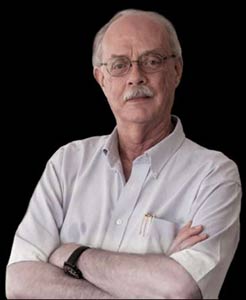
Karl J. Aufderheide, Ph.D.
Associate Professor Emeritus
Texas A&M University
He tested the first prototype of the Stratoscope in the summer of 1957, and engaged General Mills for the balloon launch. Stratoscope I was designed to be suspended below a skyhook balloon in the stratosphere, to orient its telescope to the Sun, and to take high magnification photographs of the surface of the Sun. The telescope was a 12 inch Newtonian reflector, with a 35 mm motion picture camera recording the images of the Sun's surface at a rate of once per second.
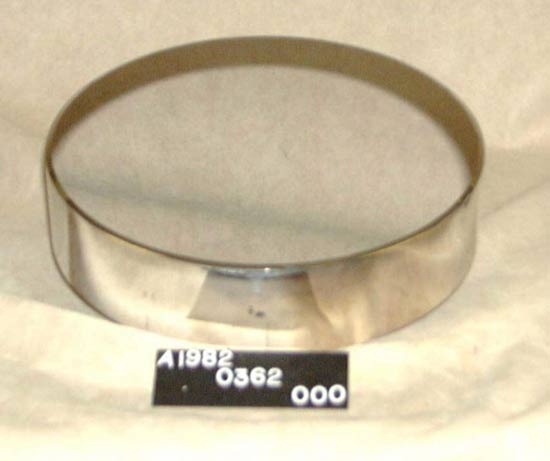
The primary 12 inch mirror for Stratoscope I. Now in the collection of the Smithsonian Air and Space Museum.
Before the first launch, Schwarzschild met with General Mills people several times to coordinate preparations for the balloon flight. My father brought me along to several of those meetings, so I had an opportunity to meet and interact with Schwarzschild before, during and after the launches.
I found Martin Schwarzschild to be an open and friendly man, extremely tolerant of a 9-year-old nerdy kid with too many questions about science and how it was done. He spent some time showing me the Stratoscope before the first launch, explaining how it was going to orient to the Sun when it was activated, and how it would record its images without a human around to adjust it.
Dr. Karl J. Aufderheide
I distinctly remember walking up to the scope in its tent at the New Brighton airport, as the photograph shows. Schwarzschild showed me the photocells that assessed the direction of the Sun and the servo motors that kept the telescope properly oriented. He even encouraged me to push the scope out of alignment so that I could see how the system corrected itself. Though I gave it a big push, the system did get itself properly reoriented within a minute or so.
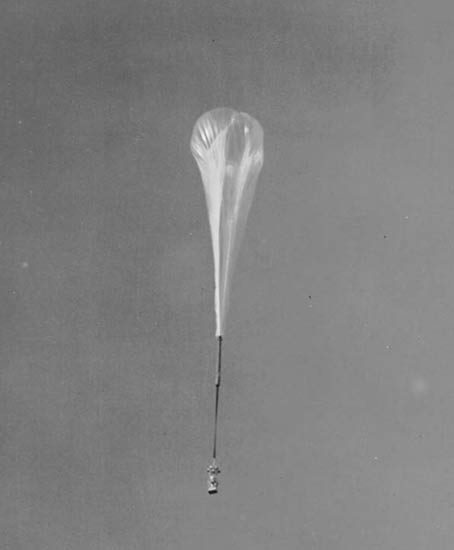
Stratoscope I soon after its launch, August 22, 1957. The robotic telescope unit hangs under the balloon, with the instrument's parachute connecting the unit to the bottom of the balloon envelope.
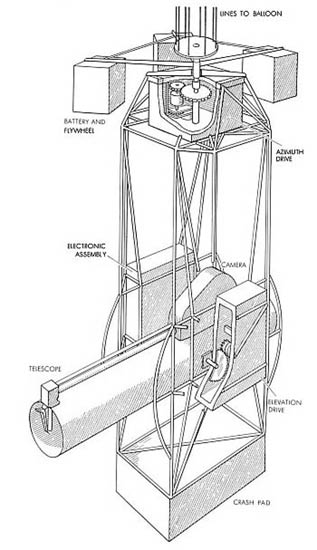
Diagram of the Stratoscope I assembly, illustrating the telescope tube, camera, and the alignment servo systems to keep the telescope trained on the Sun.
First Launch of Stratoscope I
The first launch of Stratoscope I was on August 22, 1957. Again, my father dragged me out of bed at some early hour before sunrise so that we could drive out to the New Brighton airport and watch the balloon being inflated until ready for launch. The photograph matches nearly exactly my memory of that launch, with the truck holding the telescope while the balloon was being filled with helium. My father must have parked the car behind the location where the photographer stood. During the inflation, I was usually kept in the car and out of the way of everyone else at the site, but at some point, I think I got out, just before the balloon was ready to release, because I do remember being outside. When the balloon was ready to release, there was a great deal of shouting and running about, and someone had to quickly get into the truck in the photograph to start it.
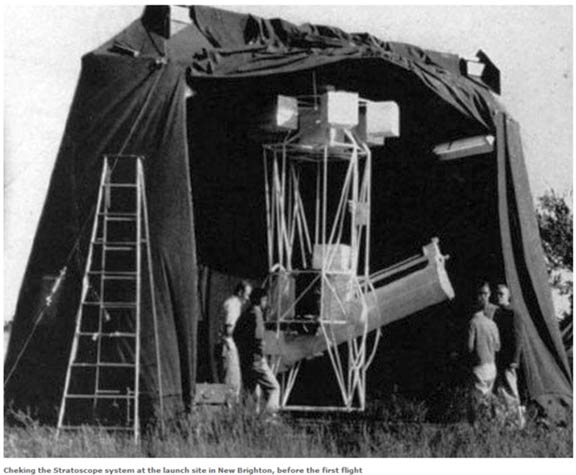
Stratoscope I being prepared for launch. I recall Schwarzschild leading me up to the instrument in this tent and showing me the telescope tube and the guidance photocells that kept it aligned to the Sun. I gave it a push and watched the system recover to proper alignment within a minute or so.
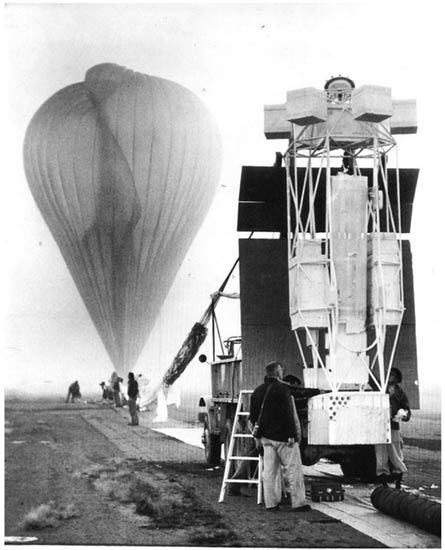
Stratoscope I just before launch early in the morning of August 22, 1957. My view of the launch from my father's car was nearly identical to this photograph, but farther away.
Coordinating the Liftoff
As the balloon was released, the truck would have to sprint to be directly under the balloon so that the cargo gondola could be lifted up directly and not dragged along the ground during launch. There was some worry, because the truck was balky starting, but its engine finally roared to life, and the driver took off at a breakneck pace to get under the rising balloon.
As the telescope lifted off the truck, I saw the telescope tube swing downward from its vertical position and bang into the frame with a loud clang, before it returned to vertical.
Dr. Karl J. Aufderheide
The balloon with its cargo lifted up into the sky. I recall Schwarzschild expressing some worry that the telescope had been damaged by that noise during launch, and I think I was able to comment that it didn't appear to have been broken in any obvious way. He did talk to me briefly about that - I'm not sure anyone else had a similar viewpoint to the launch to actually see what the clanging noise was all about, or the return of the tube to its vertical position as it lifted off.
Photos of the Sun's Granular Surface
In spite of its noisy launch, the Stratoscope flight was otherwise uneventful. The balloon carried its cargo up to about 83,000 feet. The telescope/camera system was activated, and it took pictures of the Sun, about once each second, until the film canister was exhausted. After several hours, the system cut loose from the balloon and the telescope dropped on its parachute, landing in a muddy field in southwestern Minnesota the next morning. The system and its film were recovered without damage, and Schwarzschild was delighted to have many high resolution, high magnification images of the surface of the Sun.
A second flight of the Stratoscope was done on September 25, 1957. I would have been in school by then, so I have no memories of that flight. That was even more successful, I heard, because some of the problems the instrument had during the first flight were corrected, so an even better set of images and data was collected.
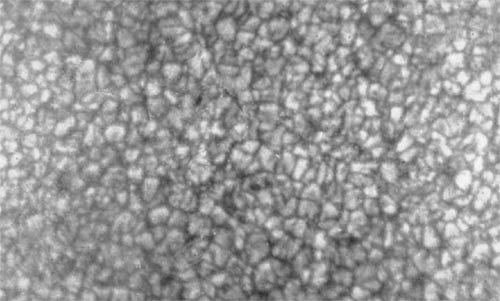
The granular nature of the surface of the Sun. Image collected from the early Stratoscope I flights. Each brighter granule is a convection cell, carrying solar energy from the interior of the Sun to radiate into space. Each granule is nearly 1,000 miles wide and endures for about 20 to 30 minutes. Images with this amount of detail were not available before the innovation of the Stratoscopes. (Image from 1959 Scientific American article by Martin and Barbara Schwarzschild.)
Early that fall, I saw Schwarzschild again. He showed me several nice prints of the Sun's images he'd acquired from the telescope. He explained the images to me, showing the granular nature of the convection cells on the surface of the photosphere, which he likened to a “bowl of oatmeal.”
Dr. Karl J. Aufderheide
He explained that the brighter structures in the granular pattern were rising columns of heated gas, carrying energy from the interior of the Sun to the surface to be radiated into space. Each granule was huge: nearly 1,000 miles wide and it persisted about 20 or 30 minutes before it was replaced by a fresh structure. He was extremely pleased by the results of the flights.
The last time I met Martin Schwarzschild, he and his wife went on a picnic with my parents and me at one of the parks in St. Paul. He brought presents for me: an astronomy book and a very early version of the Frisbee flying disc, then known as a “Pluto Platter.” I'm not sure what has happened to the book over the many years since, but I still have the Pluto Platter stored out somewhere in my workshop. A fine memorable for a fine man. Subsequently, Schwarzschild continued a series of Stratoscope balloon flights from the late 1950s into the early 1960s. Later flights were done with a second-generation instrument, Stratoscope II, which eventually had television cameras mounted on the telescope and active radio control of the images the camera was collecting. Martin Schwarzschild can be given credit for pioneering of the development of robotic telescopes placed in remote locations for advantageous viewing and monitored/adjusted by remote control. He therefore contributed to our modern satellite observatory and exploration systems, including the Hubble Space Telescope, its relatives and descendants, and the endless stunning observations those instruments are making in modern astronomical investigations.
It was a chilly twilight evening in early October, 1957. With my father, I was standing outside in the dark backyard of my suburban St. Paul house, watching the sky for something to arc overhead. The something was the Soviet satellite, Sputnik 1, launched only a day or so earlier, and garnering international attention.
Dr. Karl J. Aufderheide
Sputnik 1
Sputnik 1 had only a few instruments aboard to report conditions in Earth orbit, so the scientific information from the satellite was minimal. The batteries in Sputnik were expected to last only about two weeks, although they continued to support the radio broadcast from the satellite for about three. The iconic beeping signals from the satellite were made to be easily detected by amateur radio operators throughout the world. Sputnik's orbit was not stable and the device fell back to Earth in January of 1958.
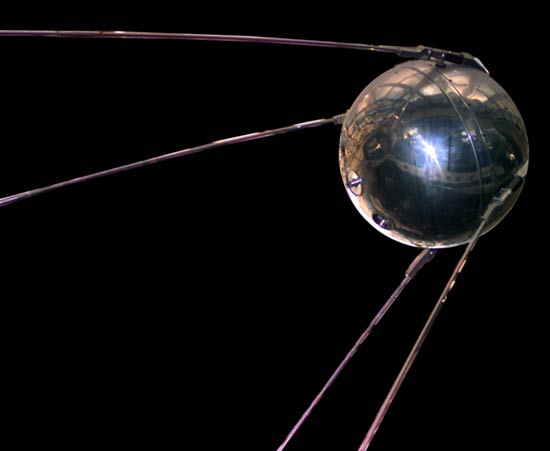
Replica of the Sputnik 1 satellite. The sphere was about 22 inches in diameter, and weighed about 184 pounds. A replica like this one was sold at auction in 2017 for over $800,000.
The value to the Soviet Union of the Sputnik 1 launch was not so much from its scientific functions. Rather, it represented a major technological and propaganda demonstration that the Soviet Union had the ability to launch an object into Earth orbit. The Cold War subtext of that feat was that, if the Soviets had the capability to launch satellites into Earth orbit, they also had the power to fling nuclear weapons over the North Pole at any desired target in the Western Hemisphere.
The Beginning of the Space Race
This capability caused a great deal of anxiety in the US, and also led to a crash program to get one or more US satellites launched as quickly as possible. Completion of the Navy's Vanguard satellite program was pushed faster than it should have been and resulted in a couple of spectacular and embarrassing launch pad failures before Werner von Braun's Army rocket program was able to launch Explorer I in January, 1958.
In another aspect of the US response, NASA was established in 1958, and many of the dispersed space and high altitude exploration research and development programs were collected under its control, to produce a more coherent program of space research and exploration.
As the twilight deepened, at last my father and I caught a glimpse of the satellite, glowing overhead and flashing in the sunlight for a few seconds as it passed overhead. We had seen Sputnik, the first human-launched satellite.
Dr. Karl J. Aufderheide
The next night, we waited outside again at dusk and were able to observe the satellite pass over for a longer time. (It was only many years later that I read that the satellite itself was tiny and nearly invisible to the naked eye, so what we likely saw passing overhead was Sputnik's booster rocket, which was following in the same orbit, was much larger, and was painted to be easily reflective and visible on the ground. The booster was tumbling, which explained why we saw a regular brighter-dimmer flash as it passed overhead.)
Sputnik 1's launch certainly marked the beginning of the “Space Race,” as a component of the Cold War prevalent throughout much of the second half of the 20th Century. But its launch also marked the beginning of the “Space Age:” the accelerating pace of technological developments related to our ever expanding ability to explore the universe. These are some of my memories of that vivid summer long ago, before the onset of the NASA space projects.
Part I of Dr. Karl Aufderheide's childhood memories of the Stratoscope I balloon can be found in the Fall 2019 edition of The Observer, newsletter for the Brazos Valley Astronomy Club.
Click here to read Part I.